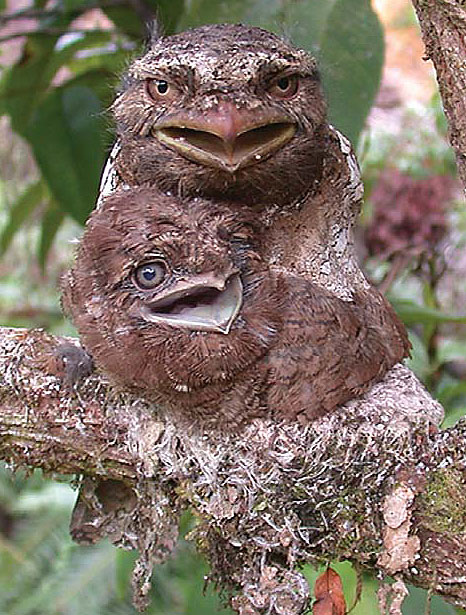
Sri Lanka Frogmouth
[order] CAPRIMULGIFORMES | [family] Podargidae | [latin] Batrachostomus moniliger | [UK] Sri Lanka Frogmouth | [FR] Podarge de Ceylan | [DE] Ceylon-Froschmaul | [ES] Podargo de Ceilan | [NL] Ceylonkikkerbek
Subspecies
Monotypic species
Physical charateristics
The Sri Lanka Frogmouth is about 23 cm long. It looks large-headed, and has a large flattened hooked bill and huge frog-like gape. The female is rufous, lightly spotted with white. The male is grey and more heavily spotted.
The Sri Lanka Frogmouth hunts insects at night and rests during the day. The Sri Lankan frogmouth is not very adept at flying and can seem weak in flight, yet it can fly quietly under the thick canopy at night to hunt for insects. It can be identified at night by its klock-klock-klock-klock-klock calls which can best be described as loud, cackly and frog like. It has the same quality as of pebbles rattling down. This klock-klock call is of the male and is answered with a long and harsh krsssshhh by the female.
The Sri Lanka Frogmouth hunts insects at night and rests during the day. The Sri Lankan frogmouth is not very adept at flying and can seem weak in flight, yet it can fly quietly under the thick canopy at night to hunt for insects. It can be identified at night by its klock-klock-klock-klock-klock calls which can best be described as loud, cackly and frog like. It has the same quality as of pebbles rattling down. This klock-klock call is of the male and is answered with a long and harsh krsssshhh by the female.
| wingspan min.: | 0 | cm | wingspan max.: | 0 | cm |
| size min.: | 22 | cm | size max.: | 23 | cm |
| incubation min.: | 0 | days | incubation max.: | 0 | days |
| fledging min.: | 0 | days | fledging max.: | 0 | days |
| broods: | 0 | eggs min.: | 0 | ||
| eggs max.: | 0 |
Range
Oriental Region : South India, Sri Lanka
Habitat
The Sri Lanka Frogmouth inhabits dense tropical rainforest and is sometimes found in shade grown coffee plantations. It is found only in the Western Ghats of southwest India and Sri Lanka.
Reproduction
It builds a nest in the fork of a tree from 2?6m above the ground, lining it with moss, small leaves, twigs and underfeathers. A single white egg is laid and is incubated by the female at night and the male during the day. The white chick is cared for over a period of weeks before dispersing. Second down of the chick is rufous-buf and barred.
Feeding habits
The Sri Lankan frogmouth is nocturnal, hunting insects at night and resting on branches during the day.
Conservation
This species has a very large range, and hence does not approach the thresholds for Vulnerable under the range size criterion (Extent of Occurrence <20,000 km2 combined with a declining or fluctuating range size, habitat extent/quality, or population size and a small number of locations or severe fragmentation). The population trend appears to be stable, and hence the species does not approach the thresholds for Vulnerable under the population trend criterion (>30% decline over ten years or three generations). The population size has not been quantified, but it is not believed to approach the thresholds for Vulnerable under the population size criterion (<10,000 mature individuals with a continuing decline estimated to be >10% in ten years or three generations, or with a specified population structure). For these reasons the species is evaluated as Least Concern.
The Sri Lankan frogmouth can inhabit shade-grown coffee plantations, which require the presence of the taller trees of native forest, and are therefore relatively ecologically sound. However, a recent trend has seen tea plantations becoming more profitable than coffee plantations, leading to the destruction of native forests. Habitat is also being lost to fires, forestry operations, water resource development, cultivation and grazing

Migration
Probably sedentary
Distribution map

